 W
WPortrait of the Artist Holding a Thistle is an oil painting on parchment pasted on canvas by German artist Albrecht Dürer. Painted in 1493, it is the earliest of Dürer's painted self-portraits and has been identified as one of the first self-portraits painted by a Northern artist. It was acquired in 1922 by the Louvre in Paris.
 W
WArtists in Isabey's Studio is a painting of 1798 by the French artist Louis Léopold Boilly, showing many artists who were influential under the French Directory. It was displayed with 529 other works at the 1798 Paris Salon, which was mainly noted for Gérard's Psyche and Cupid. It is now in the Louvre, whose collections it entered in 1911.
 W
WLa Belle Ferronnière is a portrait of a lady, usually attributed to Leonardo da Vinci, in the Louvre. It is also known as Portrait of an Unknown Woman. The painting's title, applied as early as the seventeenth century, identifying the sitter as the wife or daughter of an ironmonger, was said to be discreetly alluding to a reputed mistress of Francis I of France, married to a certain Le Ferron. Later she was identified as Lucretia Crivelli, a married lady-in-waiting to Duchess Beatrice of Milan, who became another of the Duke's mistresses.
 W
WPortrait of Monsieur Bertin is an 1832 oil on canvas painting by Jean-Auguste-Dominique Ingres. It depicts Louis-François Bertin (1766–1841), the French writer, art collector and director of the pro-royalist Journal des débats. Ingres completed the portrait during his first period of success; having achieved acclaim as a history painter, he accepted portrait commissions with reluctance, regarding them as a distraction from more important work. Bertin was a friend and a politically active member of the French upper-middle class. Ingres presents him as a personification of the commercially minded leaders of the liberal reign of Louis Philippe I. He is physically imposing and self-assured, but his real-life personality shines through – warm, wry and engaging to those who had earned his trust.
 W
WBoy with a Spinning-Top or Child with a Teetotum is a 1738 painting by Jean Siméon Chardin, now in the Louvre in Paris, which acquired it in 1907.
 W
WPortrait of Doña Isabel de Requesens y Enríquez de Cardona-Anglesola is an oil painting dated circa 1518 that was formerly believed to depict Giovanna d'Aragona. It has been variously ascribed to Raphael, Giulio Romano, or the school of Raphael; it is now usually taken to have been executed by Giulio Romano based on a sketch by Raphael and then altered by Raphael. The painting is now in the Louvre Museum in Lens.
 W
WPortrait of Baldassare Castiglione is a c. 1514–1515 oil painting attributed to the Italian High Renaissance painter Raphael. Considered one of the great portraits of the Renaissance, it has an enduring influence. It depicts Raphael's friend, the diplomat and humanist Baldassare Castiglione, who is considered a quintessential example of the High Renaissance gentleman.
 W
WAline Chassériau is an 1835 oil on canvas painting by French romantic artist Théodore Chassériau, which represents Aline Chassériau (1822–1871), the painter's younger sister. Once owned by the artist's brother Frédéric, it was given to the Musée du Louvre by Baron Arthur Chassériau and his wife in 1918.
 W
WThe Portrait of a Clad Warrior, also known as Portrait of Gaston of Foix is a painting by the Italian High Renaissance painter Girolamo Savoldo, dating to c. 1529 and housed in the Louvre Museum of Paris, France.
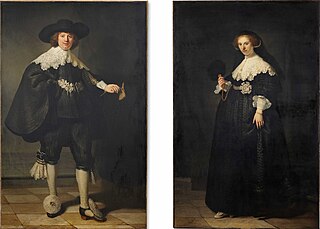 W
WThe pendant portraits of Marten Soolmans and Oopjen Coppit are a pair of full-length wedding portraits by Rembrandt. They were painted on the occasion of the marriage of Marten Soolmans and Oopjen Coppit in 1634. Formerly owned by the Rothschild family, they became joinedly owned by the Louvre Museum and the Rijksmuseum in 2015 after both museums managed to contribute half of the purchase price of €160 million, a record for works by Rembrandt.
 W
WThe Coronation of Napoleon is a painting completed in 1807 by Jacques-Louis David, the official painter of Napoleon, depicting the coronation of Napoleon at Notre-Dame de Paris. The painting has imposing dimensions, as it is almost 10 metres (33 ft) wide by a little over 6 metres (20 ft) tall and was completed in the medium of oil painting. The work is on display at the Louvre Museum in Paris.
 W
WPortrait of Antonio de Covarrubias is a 1595-1600 oil on canvas painting by El Greco, dating to his time in Toledo. It is now in the Louvre in Paris as the result of an exchange with Spanish museums in 1941.
 W
WHans Holbein the Younger painted the Portrait of Erasmus of Rotterdam several times, and his paintings were much copied, at the time and later. It is difficult to disentangle Holbein's original work from that of his workshop and other copyists. Possibly five largely original versions survive, as well as a number of drawings made as studies.
 W
WPortrait of Nicolaus Kratzer is a 1528 half-length oil on canvas portrait by Hans Holbein the Younger. It is now in the Louvre, whilst a copy after it hangs in the National Portrait Gallery. It shows the astronomer Nikolaus Kratzer, a friend of Thomas More and Holbein himself. In his hand he holds a half-finished polyhedral sundial, whilst on the shelves behind him are a semi-circular star quadrant, a shepherd's dial and other instruments.
 W
WThe portrait of Mademoiselle Caroline Rivière was painted in 1806 by the French Neoclassical artist Jean-Auguste-Dominique Ingres, and today hangs in the Louvre.
 W
WMademoiselle Rose is a painting by French Romantic artist Eugène Delacroix, regarded as the leader of the French Romantic school. This nude was painted before 1824, and is currently held and exhibited at the Louvre in Paris. Another is at the Alte Nationalgalerie in Berlin.
 W
WThe Portrait of Sigismondo Pandolfo Malatesta is a painting attributed to the Italian Renaissance master Piero della Francesca. It portrays the condottiero and lord of Rimini and Fano Sigismondo Pandolfo Malatesta, and is housed in the Musée du Louvre of Paris.
 W
WThe Man with a Glove is an oil-on-canvas portrait by the Italian Renaissance artist Titian, c. 1520. It is part of the collections of the Musée du Louvre, Paris.
 W
WThe Mona Lisa is a half-length portrait painting by Italian artist Leonardo da Vinci. Considered an archetypal masterpiece of the Italian Renaissance, it has been described as "the best known, the most visited, the most written about, the most sung about, the most parodied work of art in the world". The painting's novel qualities include the subject's enigmatic expression, the monumentality of the composition, the subtle modelling of forms, and the atmospheric illusionism.
 W
WNapoleon I on his Imperial Throne is an 1806 portrait of Napoleon I of France in his coronation costume, painted by the French painter Jean-Auguste-Dominique Ingres.
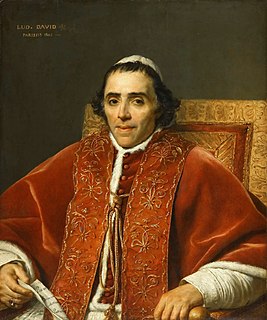 W
WThe Portrait of Pope Pius VII is an 1805 portrait of Pope Pius VII by the French painter Jacques-Louis David to thank the pope for assisting at the coronation of Napoleon I of France. Pope Pius appears in David's The Coronation of Napoleon, depicted as blessing the emperor, when in fact he was merely a spectator, assisting at the ceremony with a resigned expression throughout.
 W
WThe Portrait of Frédéric Chopin and George Sand was an 1838 unfinished oil-on-canvas painting by French artist Eugène Delacroix. Originally a double portrait, it was later cut in two and sold off as separate pieces. It showed composer Frédéric Chopin (1810–49) playing the piano while writer George Sand (1804–76) sits to his right, listening and sewing. The sitters were lovers at the time, and both were close friends of the artist.
 W
WPortrait of Princess is a tempera painting on panel attributed to the Italian Late-Gothic master Pisanello. It was probably executed between 1435 and 1445 and is also known as Portrait of a Princess of the House of Este. It is firmly attributed to Pisanello on stylistic grounds and because he stayed in Ferrara in the period, where he also finished a portrait and a celebrative medal of Marquis Leonello d'Este.
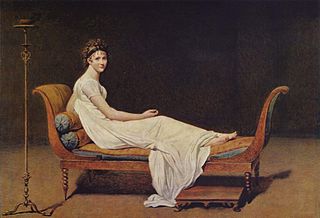 W
WPortrait of Madame Récamier is an 1800 portrait of the Parisian socialite Juliette Récamier by Jacques-Louis David showing her in the height of Neoclassical fashion, reclining on a Directoire style sofa in a simple Empire line dress with almost bare arms, and short hair "à la Titus."
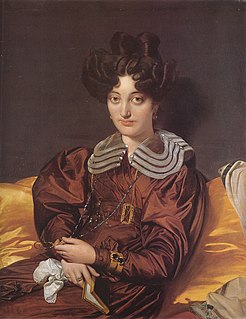 W
WPortrait of Madame Marcotte de Sainte-Marie is an 1826 painting by Jean-Auguste-Dominique Ingres of Suzanne Clarisse de Salvaing de Boissieu, wife of Marie Marcotte de Sainte-Marie. It is one of his earliest surviving portraits and one of the few portraits of women he produced in Paris straight after his return from Rome. Studies for it are now in the Louvre and a gallery in Montauban.
 W
WSelf Portrait is a self-portrait by Tintoretto, dating to around 1588. It was bought for Marie Antoinette with the chateau de Saint-Cloud in 1785. It is now in the Louvre.
 W
WSelf-Portrait, or Portrait of the Artist in a Redingote, is an 1835 oil-on-canvas painting by French romantic artist Théodore Chassériau, which was painted when the artist was 16. It is currently housed at the Musée du Louvre.
 W
WThe Self-portrait is a self-portrait painted by the artist Jacques-Louis David in 1794 whilst in prison at the hôtel des fermes for having supported the robespierristes. It was his third and last self-portrait - the second was the 1791 Aux trois collets. He gave it to his former student Jean-Baptiste Isabey and it then entered the collections of the Louvre in 1852.
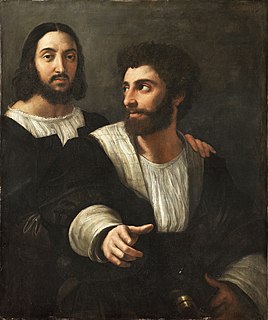 W
WThe Self-Portrait with a Friend is a painting by Italian High Renaissance painter Raphael. It dates to 1518–1520, and is in the Louvre Museum of Paris, France. Whether the figure on the left is actually a self-portrait by Raphael is uncertain, although it was already identified as such in a 16th-century print.
 W
WThe pendant portraits of Marten Soolmans and Oopjen Coppit are a pair of full-length wedding portraits by Rembrandt. They were painted on the occasion of the marriage of Marten Soolmans and Oopjen Coppit in 1634. Formerly owned by the Rothschild family, they became joinedly owned by the Louvre Museum and the Rijksmuseum in 2015 after both museums managed to contribute half of the purchase price of €160 million, a record for works by Rembrandt.
 W
WThe pendant portraits of Marten Soolmans and Oopjen Coppit are a pair of full-length wedding portraits by Rembrandt. They were painted on the occasion of the marriage of Marten Soolmans and Oopjen Coppit in 1634. Formerly owned by the Rothschild family, they became joinedly owned by the Louvre Museum and the Rijksmuseum in 2015 after both museums managed to contribute half of the purchase price of €160 million, a record for works by Rembrandt.
 W
WThe Portrait of Madame Marie-Louise Trudaine is an unfinished 1791–1792 portrait of Marie-Louise Trudaine by the French painter Jacques-Louis David. It was commissioned from David by her brothers-in-law, the Trudaine brothers who welcomed David, the poet André Chénier, and other major artists of the time to their Parisian salon at place des Vosges. It shows her seated on a simple chaise, with her hands crossed on her lap and wearing a sober dress, a blue waist-sash and a white collar. Her expression is worried and reinforced by the tormented background and her unkempt hair.
 W
WThe Two Sisters is an 1843 oil painting on canvas by the French romantic artist Théodore Chassériau. Completed when the artist was twenty-three years of age, it depicts Chassériau's sisters Adèle and Aline. It is housed in the Musée du Louvre in Paris, France.
 W
WHenriette de Verninac (1780–1827) was the daughter of Charles-François Delacroix, minister of Foreign Affairs under the Directory, and wife of the diplomat Raymond de Verninac Saint-Maur. She is known as the subject of a portrait by Jacques-Louis David.
 W
WPortrait of Alof de Wignacourt with his Page is a painting by the Italian master Caravaggio, in the Louvre of Paris.
 W
WPortrait of a Young Man is a 32×26 cm oil on panel portrait painting by Giovanni Bellini, dating to c.1490–1495 and now in the Louvre in Paris, to whom it was given by comte Albert de Vandeul in 1902.